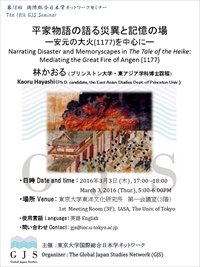The 18th GJS SeminarNarrating Disaster and Memoryscapes in The Tale of the Heike:
Mediating the Great Fire of Angen (1177)
| Date and time: | March 3, 2016 (Thur.), 5:00-6:00PM |
|---|---|
| Venue: | 1st Meeting Room (3F), Institute for Advanced Studies on Asia, The University of Tokyo |
| Speaker: | Kaoru Hayashi (Ph.D. Candidate, Department of East Asian Studies, Princeton University) |
| Language: | English |

Abstract: Japan’s old capital, Heian-kyō (present-day Kyoto) witnessed countless calamities in the late twelfth century. Wars, fires, epidemics, floods, droughts and earthquakes periodically devastated the city. Among the incessant calamities, the great fire of Angen (1177) burned down a third of the capital, including the Great Imperial Audience Hall, courtier mansions, and other well-known buildings and gardens. This fire in particular stands out in The Tale of the Heike, or Heike monogatari, as the conclusion of the first chapter, heralding the end of the court aristocracy represented by the Fujiwara family. For this presentation, I draw on the depiction of the fire as it is narrated in several variants of Heike monogatari. By examining the differences in the damaged locations and spaces described in variants of the tale and other historical records, I argue that these lists of locations signal important memory and narrative making processes. The tale serves as a medium for remembering and reconstructing the enduring memory of the old capital and its spaces. Exploring the literary significance and rhetoric of historical and commemorative spaces reveals the celebrated and haunted past of Heian-kyō and its aristocratic culture and politics.
Organizer: The Global Japan Studies Network (GJS)Contact: gjs[at]ioc.u-tokyo.ac.jp



